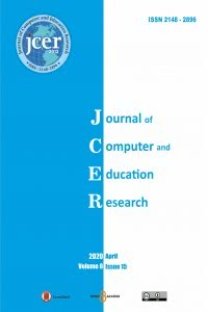Individual and Collaborative Computerized Mind Mapping as a Pre-Writing Strategy: Effects on EFL Students’ Writing
Computerized mind mapping, L2 writing, collaboration, english as a foreign language
Individual and Collaborative Computerized Mind Mapping as a Pre-Writing Strategy: Effects on EFL Students’ Writing
___
- Abrams, Zs. I., & Byrd, D. R. (2016). The effects of pre-task planning on L2 writing: Mind-mapping and chronological sequencing in a 1st-year German class. System, 63, 1-12.
- Al-Shaer, I. (2014). Employing concept mapping as a pre-writing strategy to help EFL learners better generate argumentative compositions. International Journal for the Scholarship of Teaching and Learning, 8(2).
- Anderson-Inman, L., & Zeitz, L. (1993). Computer-based concept mapping: Active studying for active learners. The Computing Teacher, 21(1), 1-5.
- Chiou, C. C. (2015). The Comparative Effect of Computer-Assisted and Paper-and-Pencil Concept Mapping on Learning Motivation and Achievement. International Journal of Information and Education Technology 5(9), 668-671.
- Crookes, G. (1989). Planning and interlanguage variation. Studies in Second Language Acquisition, 11(4), 367–383.
- Ellis, R. (1987). Interlanguage variability in narrative discourse: Style in the use of the past tense. Studies in Second Language Acquisition, 9(1), 12–20.
- Ellis, R., & Yuan, F. (2004). The effects of planning on fluency, complexity, and accuracy in second language narrative writing. Studies in Second Language Acquisition, 26(1), 59–84.
- Field, A. (2009). Discovering statistic using SPSS. London: SAGE Publications.
- Flower, L., & Hayes, J.R. (1981). A cognitive process theory of writing. College Composition and Communication, 32, 365-387.
- Jacobs. H. L., Zinkgraf, S. A., Wormuth, D. R., Hartfiel, V. F., & Hughey, J. B. (1981). Testing ESL composition: A practical approach. Rowley, MA: Newbury House.
- Johnson, M. D. (2014). Does planning really help?: Effectiveness of planning in L2 writing. Journal of Second Language Teaching and Research, 3(1), 107-118.
- Johnson, M. D., Mercado, L., & Acevedo, A. (2012). The effect of pre-task planning sub-processes on L2 writing fluency, grammatical complexity, and lexical complexity. Journal of Second Language Writing, 21(3), 264-282.
- Lee, Y. J. (2013). Collaborative concept mapping as a pre-writing strategy for L2 learning: A Korean application. International Journal of Information and Education Technology, 3(2), 254-258.
- Liu, P. L. (2011). A study on the use of computerized concept mapping to assist ESL learners’ writing. Computers & Education, 57(4), 2548–2558.
- Mehnert, U. (1998). The effects of different lengths of time for planning on second language performance. Studies in Second Language Acquisition, 20(1), 83–108.
- Neumann, H., & McDonough, K. (2015). Exploring student interaction during collaborative prewriting discussions and its relationship to L2 writing. Journal of Second Language Writing, 27, 84–104.
- Novak, J. D. (1998). Learning, creating, and using knowledge: Concept maps as facilitative tools in schools and corporations. Mahwah, NJ: Lawrence Erlbaum.
- Novak, J. D., & Cañas, A. J. (2008). The theory underlying concept maps and how to construct and use them (Technical Report IHMC CmapTools 2006-01 Rev 01-2008). Pensacola, FL: Florida Institute for Human and Machine Cognition. 1-36.
- Novak, J. D., & Gowin, D. B., (1984). Learning how to learn. Cambridge and New York: Cambridge University Press.
- Ojima, M. (2006). Concept mapping a pre-task planning: A case study of three Japanese ESL writers. System, 34(4), 566-585.
- Ortega, L. (1999). Planning and focus on form in L2 oral performance. Studies in Second Language Acquisition, 21(1), 109–148.
- Plonsky, L., & Oswald, F.L. (2014). How big is “big”? Interpreting effect sizes in L2 research. Language Learning, 64(4), 878-912.
- Reader, W., & Hammond, N. (1994). Computer-based tools to support learning from hypertext: Concept mapping tools and beyond. Computers & Education, 12(1-2), 99–106.
- Schoonen, R., Snellings, P., Stevenson, M., & van Gelderen, A. (2009). Toward a blueprint of the foreign language writer: The linguistic and cognitive demands of foreign language writing. In R. M. Manchón (Ed.), Writing in foreign language contexts (pp. 77–101). Bristol: Multilingual Matters.
- Schultz, M. (1991). Mapping and cognitive development in the teaching of foreign language writing. The French Review, 64(6), 978–988.
- Shi, L. (1998). Effects of prewriting discussions on adult ESL students’ compositions. Journal of Second Language Writing, 7(3), 319–345.
- Skehan, P., & Foster, P. (1997). Task type and task processing conditions as influences on foreign language performance. Language Teaching Research, 1(3), 185–211.
- Sokolik, M. (2003). Writing. In D. Nunan (ed.) Practical English language teaching. New York: McGraw-Hill.
- Sturm, J., & Rankin-Erickson, J. (2002). Effects of hand-drawn and computer generated concept mapping on the expository writing of middle school students with learning disabilities. Learning Disabilities Research and Practice, 17(2), 124–139.
- Zaid, M. A. (2011). Effects of web-based pre-writing activities on college EFL students’ writing performance and their writing apprehension. Journal of King Saud University – Languages and Translation, 23(2), 77-85.
- Zhang, Y. (2018). A contrastive study on the application of mind maps in argumentative writing instruction for EFL learners. English Language Teaching, 11(12), 93-100.
- Yayın Aralığı: 2
- Başlangıç: 2013
- Yayıncı: Tamer KUTLUCA
Investigation of Preschool Preservice Teachers' Perceptions of Scientific Knowledge through Metaphor
Use of Arithmetic Operation Skills in Block Based Programming Environments: A Comparative Case Study
Hayal YAVUZ MUMCU, Suheda MUMCU, Ünal ÇAKIROĞLU
The Examination of Prospective Mathematics Teachers' Perceptions of Lifelong Learning Competencies
Buket ASLANDAĞ, Murtaza AYKAÇ, Davut KÖĞCE
Serbest Etkinlik Uygulamalarının Sınıf Öğretmenlerinin Görüşlerine Göre Değerlendirilmesi
